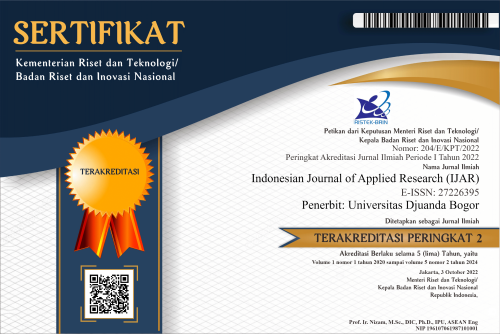Diurnal Circadian Variation in Photosynthesis in Dracaena Sanderiana Under Contrasting Temperature and Light
Abstract
Dracaena sanderiana is prominent and in-demand cut foliage in the global ornamental industry. This study was conducted to examine the stress responses of Dracaena sanderiana under contrasting temperature and light conditions by using chlorophyll fluorescence (ChlF) transient analysis technique. D. sanderiana cuttings were held in distilled water and subjected to two different light levels, i.e., 22,500±2,000 lux and 750±200 lux allowing two distinct temperature levels. The chlorophyll fluorescence data were collected through OJIP analysis using a portable fluorometer (FluorPen, FP 110). The measurements were recorded four times a day (9 am, 12 pm, 3 pm, and 6 pm) and the data were collected continuously for four days commencing from the first day of treatment application. The major parameters derived from the OJIP analysis, including specific energy fluxes per reaction center (ABS/RC, TR/RC, ET/RC, and DI/RC), flux ratios (maximum quantum yield of primary photochemistry-φPo, electron transport efficiency -ψo, and quantum yield of electron transport –φEo and maximum quantum yield of non-photochemical de-excitation- φDo), and performance index (PI) were recorded. ChlF data showed a clear unimodal diurnal variation in plant performances of D. sanderiana at 22,500±2,000 lux. The circadian variation was reported for all measured ChlF parameters except the ψo, TR/RC, and ET/RC. Based on these circadian variations of ChlF, it can be concluded that D. sanderiana displays a facultative CAM pathway as an adaptation to the stressed conditions.
References
Adams, W. W., Diaz, M., & Winter, K. (1989). Diurnal changes in photochemical efficiency, the reduction state of Q, radiationless energy dissipation, and non-photochemical fluorescence quenching in cacti exposed to natural sunlight in northern Venezuela. Oecologia, 80(4), 553-561.
Beura, S. K., Mohapatra, K. B., Paul, P. K., & Nandi, A. (2007). Chemical management of Cercospora blight of okra in Orissa. Journal of Plant Protection and Environment, 4(2), 134-137.
Buschmann, C., & Buchanan-Bollig, I. C. (1983). Changes of the chlorophyll fluorescence induction kinetics of C 3 and CAM plants during day/night cycles. Photosynthesis research, 4(4), 337-349.
Ceusters, N., Valcke, R., Frans, M., Claes, J. E., Van den Ende, W., & Ceusters, J. (2019). Performance index and PSII connectivity under drought and contrasting light regimes in the CAM orchid Phalaenopsis. Frontiers in plant science, 10, 1012.
Herrera, A. (2009). Crassulacean acid metabolism and fitness under water deficit stress: if not for carbon gain, what is facultative CAM good for?. Annals of botany, 103(4), 645-653.
Luttge, U. (2000). Light-stress and crassulacean acid metabolism. PHYTON-HORN-, 40(3), 65-82.
Keiller, D. R., Slocombe, S. P., & Cockburn, W. (1994). Analysis of chlorophyll a fluorescence in C3 and CAM forms of Mesembryanthemum crystallinum. Journal of Experimental Botany, 45(3), 325-334.
Laisk, A., Oja, V., Rasulov, B., Eichelmann, H., & Sumberg, A. (1997). Quantum yields and rate constants of photochemical and nonphotochemical excitation quenching (experiment and model). Plant Physiology, 115(2), 803-815.
Niewiadomska, E., Bilger, W., Gruca, M., Mulisch, M., Miszalski, Z., & Krupinska, K. (2011). CAM-related changes in chloroplastic metabolism of Mesembryanthemum crystallinum L. Planta, 233(2), 275-285.
Skillman, J. B., & Winter, K. (1997). High photosynthetic capacity in a shade-tolerant crassulacean acid metabolism plant (implications for sunfleck use, nonphotochemical energy dissipation, and susceptibility to photoinhibition). Plant Physiology, 113(2), 441-450.
Winter, K., & Holtum, J. A. (2014). Facultative crassulacean acid metabolism (CAM) plants: powerful tools for unravelling the functional elements of CAM photosynthesis. Journal of experimental botany, 65(13), 3425-3441.
Winter, K., & Smith, J. A. C. (1996). An introduction to crassulacean acid metabolism. Biochemical principles and ecological diversity. In Crassulacean acid metabolism (pp. 1-13). Springer, Berlin, Heidelberg.
Copyright (c) 2022 Indonesian Journal of Applied Research (IJAR)

This work is licensed under a Creative Commons Attribution-ShareAlike 4.0 International License.
The Authors submitting a manuscript do so on the understanding that if accepted for publication, copyright publishing of the article shall be assigned/transferred to Indonesian Journal of Applied Research (IJAR) Universitas Djuanda as Publisher of the journal. Upon acceptance of an article, authors will be asked to complete a 'Copyright Transfer Agreement'. An e-mail will be sent to the corresponding author confirming receipt of the manuscript together with a 'Copyright Transfer Agreement' form by online version of this agreement.
Indonesian Journal of Applied Research (IJAR) Universitas Djuanda, the Editors and the Editorial Board make every effort to ensure that no wrong or misleading data, opinions or statements be published in the journal. In any way, the contents of the articles and advertisements published in the Indonesian Journal of Applied Research (IJAR) Universitas Djuanda are sole and exclusive responsibility of their respective authors and advertisers.
Remember, even though we ask for a transfer of copyright, our journal authors retain (or are granted back) significant scholarly rights as mention before.
The Copyright Transfer Agreement (CTA) Form can be downloaded here: Copyright Transfer Agreement-IJAR 2020
The copyright form should be signed electronically and send to the Editorial Office e-mail below:
Prof. Dr. Ir. Dede Kardaya, M.Si. (Editor-in-Chief)
Universitas Djuanda
Jl. Tol Jagorawi No.1, Ciawi, Kec. Ciawi, Bogor, Jawa Barat 16720
Website: http://journal.unida.ac.id/index.php/IJAR/index
Email: ijar@unida.ac.id






 This work is licensed under a
This work is licensed under a 